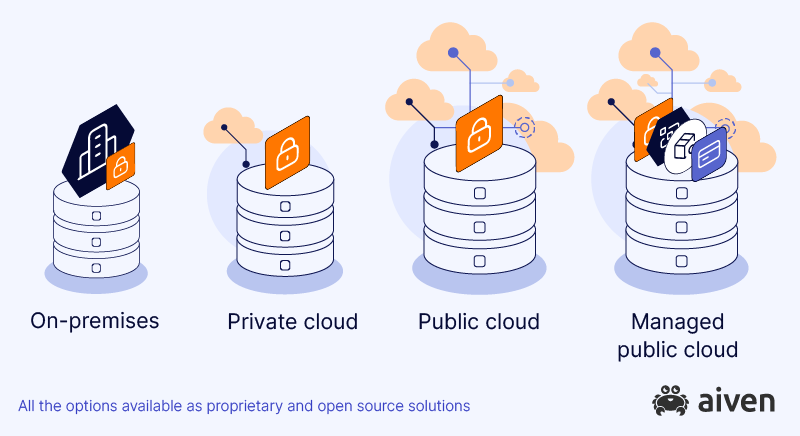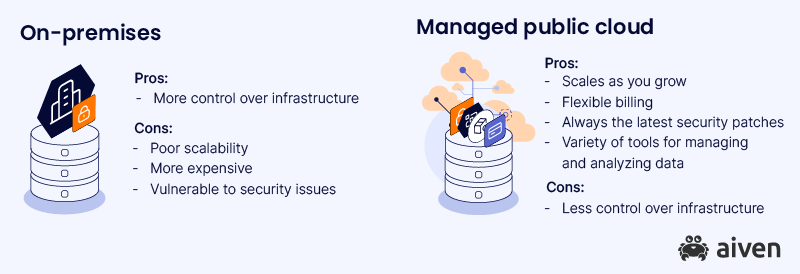Managed cloud data works for retail
Retailers are moving to the cloud in droves. Find out how they’re benefiting, and why you should brave the digital transformation too.
Auri Poso
|RSS FeedTechnical Copywriter at Aiven
Post-covid, the world has seen a sea change in the way people make purchases, taking them further in the direction of e-commerce and omnichannel shopping. And these trends look like they’re here to stay. Stories like this are why the retail business is increasingly looking at ways to level up with cloud technology, and keep their consumers engaged.
Business meets tech: cloud computing in retail
Cloud computing is just computing that happens in a cloud.
I think we can all agree that this makes it sound less intimidating. Retail businesses use computers, ergo, they can use cloud computing. The question we should be asking is: what is so special about cloud computing that makes it the right choice for retail companies?
There are two important aspects: amount and location of data.
It’s a numbers game
The retail business thrives on massive amounts of data. Inventory management and forecasting alone is a bunch of heavy-duty workloads. So is transaction processing, whether fully online or from POS terminals. Business intelligence processes need their own time and space to run, and no one wants them interrupting sales transactions.
Building up the processing and storage capabilities able to handle these is a tall order. More than that, buying and owning buildings, telecom connectivity, air-conditioning units and so on is probably not part of your core business.
Using public cloud infrastructure gives quicker access to the benefits of running heavy data loads. Everything physical lives in the provider’s buildings, you just pay for its use. Quicker ramp-up and scaling is a big factor.
Location, location, location
Another reason global companies in the retail industry in particular use cloud computing is that it allows you to bring data storage and processing closer to the point of sale.
If your offices are in Europe but your workloads are in Asia, it makes no sense to live with the lag and uncertainty of sending data back and forth. Instead, get a cloud database hosted in a nearby town, and get all the benefits and none of the lag.
More importantly still, data protection laws may prohibit transferring users’ data across borders. Global retailers can use cloud computing to ensure that personal data never leaves the country of sale while still benefiting from the business insights they can derive from concatenated, anonymous data.
Benefits of managed cloud for retail
The benefits of computing power in retail involve the whole industry. Massive amounts of data can be utilized in:
- Inventory management
- Warehouse management
- Supply chain management
- Data security
- Customer experience
- Disaster management
- POS terminal updates
- Pricing & margin management
- Loyalty-program management
- Omnichannel order fulfillment
But what are the benefits of cloud computing, specifically managed cloud computing, for retail businesses? Let’s find out.
Managed cloud is most cost-effective
Price is the big question, right? You probably weren’t expecting to see it in the benefits section.
As already discussed, investing in managed cloud infrastructure reduces the amount you spend on your physical setup. Your expenditure moves from CapEx to OpEx and you’re not stuck managing janitors and negotiating for internet connectivity.
Managed clouds are also easier to upscale and downscale than physical setups. This has important implications. If you can’t upscale at need, you have to build your infrastructure to handle peak workloads or risk serious trouble. That means that 80-90% of the time, that capacity is sitting idle but still costing you money.
All this means that the Total Cost of Ownership, spread out over years and years, is still lower with a managed cloud data service than an on-premises solution.
Faster time to market
Without the need to build infrastructure, you can get your product or service out there quickly. And not just the first release: also development and testing cycles are shorter when you can easily spin up new environments.
Process efficiency
Instead of siloed systems for each purpose that are not talking to each other, going into the cloud allows you to build an overarching data infrastructure. This platform model, enhanced with API access to any external systems, equips teams and outlets with real-time data globally. Data can be accessed wherever it’s needed.
Furthermore, the managed data platform model offers good observability to make sure that your services stay available.
Efficient supply chain and just-in-time inventory management
Effective inventory management lets retail businesses time and scale their purchases correctly. That’s why it’s an absolutely essential tool that keeps businesses afloat. Today it’s possible to track and monitor the flow of goods in real-time, allowing companies to implement just-in-time inventory management protocols.
One of the most vulnerable links in the information chain is the connectivity from the point of sale to the central inventory system. That’s where it helps to provide a data hub at a reasonable distance for all locations.
You can automate all supply chain and inventory processes. You can even take it to the next level by employing things like predictive systems working on real-time aisle location data. But that takes a lot of computing power and data storage space--only cloud setups can accommodate that much without driving you to bankruptcy.
Enhanced customer experience
A fast and smooth checkout process is a fundamental part of a good customer experience--and seller experience, if your company is a marketplace. And naturally you don’t want offline POS terminals, otherwise you face the risk of fraud. Good connectivity at checkout really pays off. (No pun intended…)
In addition to monetary transactions, consider data about loyalty programs, which have to be fetched from a centralized database; here again the data confidentiality legislation may be an obstacle, unless your data is housed locally.
But one modern use case that pretty much mandates the use of the cloud, especially for larger retailers, is omnichannel shopping. Consumers today may order their goods online, pay using a third-party app, and then pick up their goods in-store. These are all different systems, and it’s essential that they all talk to each other.
Other applications for the real-time data exchange services that a cloud platform enables include various IoT use cases and utilization of RFID technology.
Secure and reliable data environment
It’s becoming a truism that public cloud environments have the best security. After all, instead of a 1-2 person DBA team, public clouds employ a whole host of cloud professionals who keep up to date with the latest threats and are able to apply patches whenever needed. Their business depends on it--literally and directly. Cloud providers can’t afford to not have their cloud up and running, not just for reputational reasons but because they’re liable for the damages caused to their customers. SLAs are in place to ensure that compensation happens.
Tip! Check out “Data security compliance in the cloud”.
Where public clouds use open source software, it also increases security. The community that forms around an open source project will detect and eliminate vulnerabilities as well as bugs.
The careful and judicious cloud provider will also take the time to comply with all major data regulations and standards. That’s one less thing to worry about. Even if you need an Enhanced Compliance environment, a managed provider may be able to accommodate your existing account with a Bring-Your-Own-Cloud (BYOC) arrangement.
Malicious attacks aren’t the only thing you have to worry about, though. Natural disasters offer plenty of fodder for nightmares. To minimize your risks, it’s best to have your data infra distributed over a wide geographical area and set up to be durable and disaster-proof.
Related:
Make it easier for yourself and your provider to survive peak load times.)
If the worst happens, get well-versed in disaster recovery.
Open source over proprietary software
With open source software, you’ll always be able to rethink your decisions. That’s the single most important detail, but one that is too frequently overlooked. Your data should always remain yours, and proprietary software runs the risk of it being locked away, either because all exports are impossible, or because it’s in a format that’s incompatible with other systems.
Open source can also save money, but this is not a given. There are no license fees, but there are setup and maintenance costs which may exceed those of proprietary software. Moving to a managed service solves these problems, though, giving you the benefits without the downsides.
Open source software can indeed help businesses succeed and scale up, provided they have access to the talent required to implement them.
No hiring problems with managed services
Managing business-critical services requires technical expertise that, at present, is fairly thin on the ground, especially if your business isn’t located in a large city. Overall, there’s a shortage of qualified people in IT.
Cloud service providers already have people who can manage Apache Kafka or other complex pieces of software for you. By using managed services, companies can have access to experts without the hassle of finding and hiring them.
Cloud computing transforms retail - real examples
Despite its many benefits, cloud computing is not used by everyone. Nor should it be - not everyone benefits from it. However, the retail sector stands to profit hugely, as we’ve just seen.
When it comes to cloud journeys, the retail and distribution sector is definitely not limping. It’s pretty advanced on its digital transformation path, in fact, compared to other industries like insurance, consumer products and even aerospace and defense (source: a study on the cloud maturity of the retail vertical by Arthur D. Little, commissioned by Aiven).
Retailers use data more extensively than ever before. Data powers every aspect of the purchasing process, from warehouse and inventory management to customer journeys. Timely and flexible access to data is key to delivering modern retail experiences.
Let’s take a look at a few retail companies and how they use data.
- Starting from the more traditional use cases of optimizing warehousing and inventory management, Norauto, Swift and Zalando are all doing that (with Aiven’s services).
- Adeo is doing something a bit more advanced. They’re combining supply chain and inventory management with analytics to gain an overall view and deep insights spanning their entire chain of stores. They’re no longer a siloed, segmented company, but a flexible cloud-based business able to develop new capabilities at high speed.
- As for online business cases, Mirakl uses Apache Kafka® to offer an online marketplace platform, where customers can create their own marketplaces.
- And finally, Ometria uses data about customers to provide customer insights. They enable hundreds of retail marketers to create personalized marketing experiences through Ometria’s marketing platform.
Starting a retail digital transformation
If you now feel inspired to begin your company’s digital transformation or to change over to a managed service, a PaaS can definitely offer all the technological building blocks you need to reduce your risks and transform your business into a cloud-native one.
Here are some articles to get you started:
- 5 good questions to ask before moving your database
- 4 key risks in moving to the cloud (and how to mitigate, manage and master them)
P.S. We’d be remiss if we didn’t point out that Aiven offers a whole spread of open source data infrastructure solutions applicable to the retail industry.
Wrapping up
In this article, we've covered many of the questions you might want to ask about managed cloud data infra in the retail industry. If you want to become even more of an expert at this topic, you can continue on to some of our more general articles.
To catch up on some basic vocabulary, you can read for example this quick overview of public versus private clouds.
To find out why we think cloud generally beats on-prem, have a look at our popular “12 reasons” post.
For a quick overview of the logic behind open source software, glance at this post about Aiven’s relationship with OSS.
--
To get the latest news about Aiven and our services, plus a bit of extra around all things open source, subscribe to our monthly newsletter! Daily news about Aiven are available on our LinkedIn and Twitter feeds.
If you just want to stay find out about our service updates, follow our changelog.
Struggling with the management of your data infrastucture? Sign up now for your free trial at https://console.aiven.io/signup!
Stay updated with Aiven
Subscribe for the latest news and insights on open source, Aiven offerings, and more.



